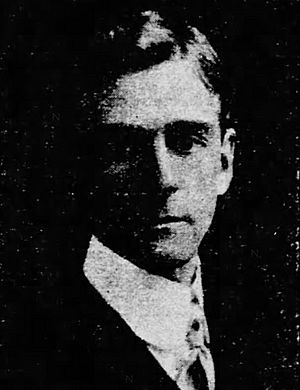John R. Swanton facts for kids
Quick facts for kids
John R. Swanton
|
|
|---|---|

Swanton in 1903
|
|
| Born | February 19, 1873 Gardiner, Maine, U.S.
|
| Died | May 2, 1958 (aged 85) |
| Alma mater | Harvard University (AB, AM, PhD) |
| Spouse(s) | Alice M. Barnard |
| Scientific career | |
| Institutions | Bureau of American Ethnology |
| Thesis | The Morphology of the Chinook Verb (1900) |
| Influences |
|
John Reed Swanton (born February 19, 1873 – died May 2, 1958) was an American expert. He studied people, their cultures, and languages. He worked with many Native American groups across the United States.
Swanton became well-known for his work in ethnology and ethnohistory. Ethnology is the study of different cultures. Ethnohistory looks at the history of cultures. He was especially famous for his studies of Native peoples in the Southeast and Pacific Northwest.
Contents
Early Life and Education
John Reed Swanton was born in Gardiner, Maine. After his father passed away, his mother, grandmother, and great aunt raised him. His mother taught him to be kind and care about fairness. She also sparked his interest in the writings of Emanuel Swedenborg.
He became interested in history and anthropology after reading The Conquest of Mexico by William H. Prescott. Anthropology is the study of human societies and cultures.
Swanton went to local schools. Then he attended Harvard University. He earned several degrees there, including a PhD in 1900. His teacher at Harvard was Frederic Ward Putnam. Putnam sent him to study linguistics with Franz Boas at Columbia University. Linguistics is the study of language. Swanton worked on his PhD paper about the Chinook language during this time.
Career and Studies
Just a few months after finishing his PhD, Swanton started working. He joined the Bureau of American Ethnology. This bureau was part of the Smithsonian Institution in Washington, DC. He worked there for over 40 years, his entire career.
At first, Swanton worked in the Northwest. He mainly studied the Tlingit and Haida peoples. He wrote down many of their stories and myths. He even wrote some of them in the Haida language. These writings helped later experts translate the poetry of Haida storytellers. Swanton spent about a year living with the Haida.
Another important area he studied was the Muskogean-speaking peoples. These groups lived in Texas, Louisiana, and Oklahoma. Swanton wrote a lot about the Creek people, Chickasaw, and Choctaw. He also studied many other groups. These included the Biloxi, Ofo, and Tunica.
Swanton wrote many books and papers. These included parts of dictionaries and studies of how languages are related. He also collected native stories and studied how different societies were organized. He worked with Earnest Gouge, a Creek man. Gouge recorded many traditional stories for Swanton. These stories were later published online.
Swanton also worked with the Caddo people. He wrote a short piece about the quipu system. This was a way the Inca people used knotted strings to record information.
Professional Groups
Swanton was a founding member of the Swedenborg Scientific Association in 1898. He was also the president of the American Anthropological Association in 1932. He helped edit their main magazine, American Anthropologist, for several years.
He was also a member of the American Folklore Society. He served as its President in 1909.
Personal Life
John Swanton married Alice M. Barnard on December 16, 1903. They had three children together. Their names were Mary Alice, John Reed Jr., and Henry Allen. Swanton passed away in Newton, Massachusetts, on May 2, 1958. He was 85 years old.
Images for kids


